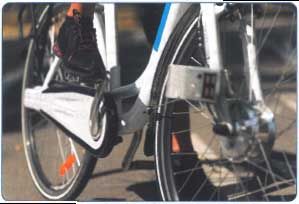by Jack McGuinn, Senior Editor
Reprinted from Power Transmission Engineering | August 2020

There is absolutely no doubt that riding an electric bicycle will not stir up cinematic memories of Marlon Brando (The Wild One) or Steve McQueen (The Great Escape) tearing it up on their hogs. Think more Pee Wee Herman and his Great Adventure.
But that’s okay, because doing so would be comparing apples to oranges. Electric bicycles-or E-bikes-are exactly that – i.e., conventional-looking bicycles that happen to be powered by battery-charged engines.
But there’s obviously more to it than that – much more.
Electric bikes are becoming very popular in coun tries around the world – where traditional bikes have long been common in Asian countries and Europe – but also in the United State. The reasoning for such popularity is that E-bikes are, for example, are a good alternative to traditional bikes for long commutes, for those in need of physical therapy with physical limitations of some kind, or, because they are simply fun.
Surprisingly, perhaps, some of the basic teclinology for E-bikes existed (and was even patented) by scientists over 100 years ago.
Essentially, electric bikes are fitted with a battery-powered motor that provides some extra oomph to the ride. Some bikes use a throttle, others are pedals-powered. And the pedal part is key in that E-bikes are not fully motorized, as are mopeds or dirt bikes. The rider still has to pedal to make it go, so E-bikes are a far cry from a traditional motorcycle.
The power supplying battery is rechargeable, of course. Thus these bikes are perfect for exercise, while also assisting riders who require. Mobility and help in getting around for those that need it- a great combination. Nosurprise that re search shows E-bike riders use them much more than regular bikes.
Given the high traffic density and extreme levels of CO2 in dense population centers in China and Japan, E-bikes are the perfect replacement for automobiles wherever practical. What makes affordable, lightweight E-bikes possible? Generally speaking, five technological advancements, some of them very technical – especially regarding the motor:
- A high-energy-density, lithium-ion chemistry rechargeable battery that was introduced by Sony in 1992 and that now powers electric cars, mobile phones, and most other modem devices. Typical electric-bike batteries weigh only6-7 pounds and can provide 1,000 cycles of charge/ discharge. The batteries are protected by electronic systems that prevent excessive temperatures and prevent damage from excessive battery discharge. Hidden inside the Bosch Active Line Plus motor housing is an array of gears, circuitry and a permanent magnet motor. Despite its complex nature, it still has Q factor, or width between cranks just 10mm greater than a standard bicycle.
- Light, powerful, and long-lasting electric motors. These are brushless permanent-magnet DC motors, their small size made possible by the same very powerful neodymium rare-earth magnets (10 times more powerful than Alnico) that have made recent automotive starters so tiny.
- Accurate, affordable non-contact torque sensors that measure the torque you apply to the pedal shaft. The shaft is magnetized in a particular direction and the torque applied by your pedaling, by just barely twisting the shaft, alters that magnetization in a measurable way, an effect known as magnetoelasticity.
- Power electronics based on fast-switching, high-current insulated-gate bipolar transistors (IGBTs). The sensors serve to continuously monitor the angular position of the motor’s rotor. A computer-phased IGBT switching of battery current to the motor s many stator windings generates a rotating magnetic field that stays just ahead of the whirling permanent magnets of the rotor, thereby strongly pulling them around at motor speeds from zero to 4,500 rpm or higher. Motor torque is multiplied and its speed reduced by two or more stages of gear reduction to assist you in driving the front sprocket.
- Digital connectivity that can allow you to communicate with your bicycle’s motor system from a smartphone or other handheld device. Although this is not necessarily key to the basic functioning of an E-bike, the interface allows for great control of performance and insight into remaining range versus speed, percentage of boost and more, that reduce range anxiety and increase our enjoyment of E-bikes.
For all practical purposes, there are two types of e-bikes. “Factory” E-bikes are designed from scratch as E-bikes. “Kit” E-bikes are ordinary bicycles with an electric motor kit retrofitted. These types of E-bikes come in many styles – from commuter bikes to full-suspension. And they’re all built for fun and clean-energy mobility. And showing up on streets around the world in ever-growing numbers . PTE
